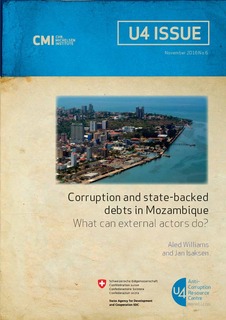| dc.contributor.author | Williams, David Aled | |
| dc.contributor.author | Isaksen, Jan | |
| dc.date.accessioned | 2018-01-04T08:22:22Z | |
| dc.date.available | 2018-01-04T08:22:22Z | |
| dc.date.issued | 2016-11-01 | |
| dc.identifier | oai:www.cmi.no:6024 | |
| dc.identifier.citation | Bergen: Chr. Michelsen Institute (U4 Issue 2016:6) 24 p | |
| dc.identifier.uri | http://hdl.handle.net/11250/2475311 | |
| dc.description.abstract | The average annual cost of corruption to Mozambique was recently estimated to be up to USD 4.9 billion for the period 2004-2014. Some analysts have entertained the idea that investments in the country's oil and gas sector could reach as high as USD 100 billion over the next decade. Mozambique recently faced a turn for the worse in its balance of payments problems because semi-public entities took out government-backed debts worth over USD 2 billion without fulfilling constitutional and legal requirements.
This U4 issue paper explores the main implications for the effectiveness of anti-corruption policies in the Mozambique case. We ask what external actors can do to alleviate corruption and prevent it from occuring again.
We encountered credible allegations that a small group of individuals within the Mozambican state violated laws to secure the loans and initially avoided public control mechanisms. Major financial discrepancies exist in terms of the use of the three loans and international development partners and domestic stakeholders suspect some form of corruption. An international firm will implement an independent audit financed by the Swedish government to look into the loans. The audit findings, and investigations by UK and Swiss financial regulatory bodies, will provide a focus for monitoring and evaluation work, possibly leading to criminal and administrative sanctions.
The main policy recommendations are summarised below. Download the pdf to also read the sections on:
A literature review of corruption and debt
Corruption and state-backed debts in Mozambique
What can be done? Entry-points for external actors
Despite two decades of experience in attempting to address corruption through development aid policy and practice, the best means of tackling various corruption challenges is still contested. Recent meta-studies focused on anti-corruption effectiveness suggest that solutions must fit specific contextual circumsta | |
| dc.language.iso | eng | |
| dc.publisher | Chr. Michelsen Institute | |
| dc.relation | U4 Issue | |
| dc.relation | 2016:6 | |
| dc.relation.ispartof | U4 Issue | |
| dc.relation.ispartofseries | U4 Issue 2016:6 | |
| dc.relation.uri | https://www.cmi.no/publications/6024-corruption-and-state-backed-debts-in-mozambique | |
| dc.subject | International Drivers of Corruption | |
| dc.subject | Illicit Financial Flows | |
| dc.subject | Mozambique | |
| dc.title | Corruption and state-backed debts in Mozambique: What can external actors do? | |
| dc.type | Research report | |
